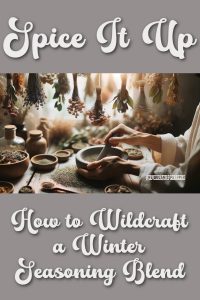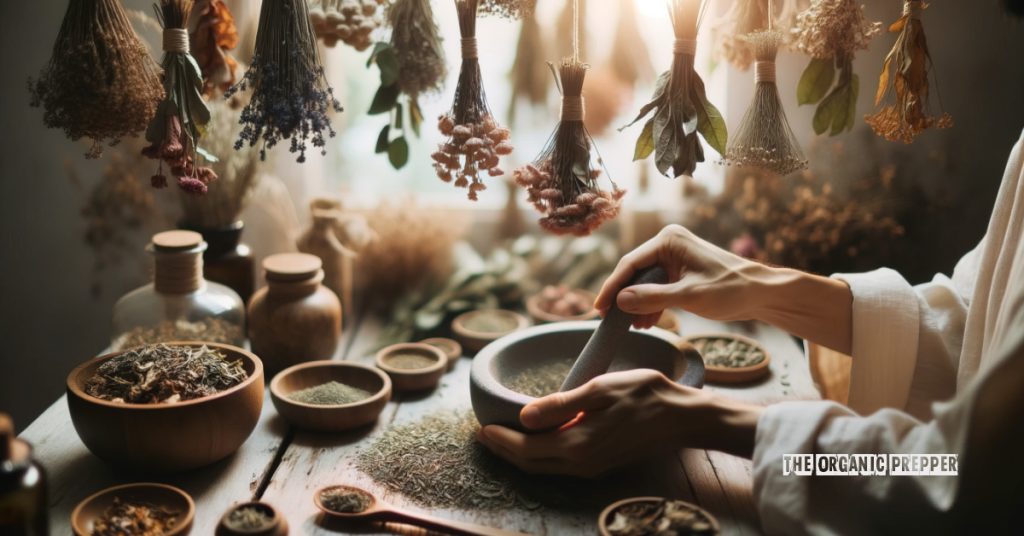If you're new here, you may want to subscribe to my RSS feed. Thanks for visiting!
by Lyza Hayn
There’s plenty to love about winter. After all, what other season gives us a free pass to snuggle up and drink hot cocoa by the fire all day? Certainly not summer.
But while I relish the opportunity to guzzle chocolate with reckless abandon, I do miss the outdoor bounty of spring and summer. There’s no denying that cold weather and snow make gardening and foraging options scarce.
If you’re pining for warm-weather produce and the rich flavors of foraged food, I’ve got some good news. You can still have a taste of the wild in wintertime by crafting your own unique seasoning blend from the food you grew and foraged all year long.
Getting started the right way
Where should you begin? With the basics, of course! A solid seasoning mix is there to spice up your food, transforming bland bites into vivacious victuals. In the case of homemade blends, it can also be a way to use up excess garden veggies and foraged edibles from the summer.
A DIY mix enables you to incorporate seasonal foods you can’t just buy at the store and taste wild foods when you can’t have them fresh. You have complete control over what goes into it, but it can’t happen without the prep work. What does that mean?
Dry it up
When you make a seasoning blend, you want to start with pre-dried ingredients. Drying produce might sound inconvenient, but think of it like this: you won’t be able to use up all 17,000 tomatoes you grew this year anyway.
Instead of letting them rot, you can simply dehydrate the excess by hanging, using a dehydrator, or whatever method you prefer. By the end of the year, you should have a solid base of dried herbs, spices, veggies, and fruits to choose from.
Keep in mind that wild mushrooms should always be cooked before consumption. If you’re using fungi, cook them first and then dehydrate them. Trust me, it’s definitely worth it in the end—cooked shrooms have a much richer umami flavor than raw.
Grind it out
You can choose to pulverize your edibles beforehand or wait to grind them down until you’re ready to start your mix. I usually grind mine right away since it makes storing them that much easier, but some believe the flavors lose potency once ground.
So, what if you forgot to forage in the summer? No sweat. Check out these cold-weather edibles to forage during fall and winter.
Combining your flavors creatively
It’s essential to start with a solid base of ingredients when creating your seasoning blend, but don’t be afraid to think outside the box. Herbs are only one part of the equation. The truth is, you can dry pretty much any edible and incorporate it into your mix.
You also aren’t confined to a foraged or homegrown-only ingredient list. If you have access to the market or grocers, you can still buy additional ingredients to incorporate. This is especially useful with cinnamon or other tropical herbs, which many people can’t grow but still want to enjoy.
Personalize it
Additionally, remember that food is medicine. Homegrown and wild-foraged foods are sometimes considered doubly so since they usually haven’t been sprayed with pesticides and genetically modified into morphological monstrosities. Consider common winter ailments like the flu and pair together herbs known to help these conditions, such as mullein and thyme.
It’s important to think about your staple dishes and how you like to flavor them. You might cook a lot of roasts for the family—in that case, why not create a fragrant dry rub with sumac and peppers? If you love baking, make your own pastry seasoning with foraged apples and wood avens root.
Get inspired
Here are some inspirational ideas to help you get started. These aren’t recipes and they’re definitely not set in stone, so play around with what you like and match it to your own palate:
- Barbecue Blitz: Rub that meat! Use garden staples like dried onions, bell peppers, hot peppers, and garlic combined with maitake mushrooms, wild ramps, or other fragrant foraged treasures.
- Chili-Palooza: Everyone needs a wintertime blend for chili. Break out your dried chilis, jalapenos, and tomatoes, sprinkling in some mustard greens and pepper-weed for good measure.
- Wild Child Pie: Pumpkin pie spice but in a feral way. Ground pumpkin fruit, sweet potato flakes, candy top mushrooms, avens root, ginger, pineapple sage, or whatever else you fancy.
- Cider Craft Rules: Drink seasonings are a thing, too! Think mulled wine or apple cider and add dried plums, apples, strawberry tops, lemongrass, mint, or lavender.
- Sick Day: Break out the chicken soup and make a wellness blend for body and soul. Use rich, healing herbs like rosemary, oregano, thyme, and basil. Wild purple dead nettle, turkey tail mushrooms, henbit, dandelion, and plantain grass are also rich in antioxidants!
The ratios are yours to determine. Everyone has different tastes, and everything can be tweaked to your liking. It’s smart to add a few teaspoons of each ingredient at a time, making tiny batches and taking notes to see what you like before making a large final batch.
When adding salt, do so sparingly. Storebought seasonings often rely on sodium for flavor, but you don’t need to fall back on such cheap tricks. Your ingredients are fresh and flavorful, standing on their own and providing a much more delicious experience. Plus, salt can always be added later if you need to sprinkle some on.
Storing your seasoning

Instead, choose smart and accessible storage containers that preserve freshness and fit right in your spice rack. It’s best to use small containers with little extra airspace since oxygen promotes staleness. Make sure your containers close tightly so that air doesn’t get in, but choose ones that are easy to open and handle.
Finally, dark-colored glass containers are much better than clear glass or plastic. Dark colors prevent degradation from UV rays and will preserve freshness longer. Glass should also eliminate the risk of compounds leeching from the container and contaminating your seasoning. Once you’ve packed your spices into the containers, set them in a cool, dark area to maintain their integrity as long as possible.
Ready to get started? Now that you know how to make your own seasoning blend from homegrown and foraged foods, you’re ready to use up all the summer bounty. Gear up for a flavorful winter, and don’t be afraid to get spicy!
What about you?
Do you have any foraged items you like to use to spice things up? Do you make your own spice blends? Do you have any tips or suggestions to add here?
Let’s have a spicy talk in the comments section!
About Lyza
Lyza Hayn is an Ozark native forest-dweller and seasoned survival kitchen whizz. Foraging is her passion and wildcrafting is her (elderberry) jam. She knows how to gather, cook, and preserve hundreds of wild edibles, tincturing and pharmacrafting dozens more. By focusing on alternative food sources and natural remedies, Lyza knows we can all live a more independent lifestyle. Her mission is to help others utilize the world around them to reduce their dependence on established systems and create a more self-reliant future.
You can check out her website at www.letteredbylyza.com or follow her on Instagram @yourmountainhome to see her point of view in photographs.

















Great Article! All year long I dry herbs for teas in the winter. I buy fresh, frozen or even canned veggies and fruits when on sale and dehydrate them. To rotate my dehydrated things my husband uses a Magic Bullet to grind veggies into a seasoning to use all year long. Then I just start dehydrating all over again. Now we live somewhere where we can grow our garden and use some our own veggies. Can’t wait for spring!!!!
Really enjoyed this article. Learned a lot.